 PART TWO
PART TWO
By Pepper Parr
BURLINGTON, ON January 9, 2010 – When Christine Iamonaco saw the ad she knew instantly “that job was meant for me”. While putting together her resume she got calls from colleagues, who alerted her to the job opportunity. It didn’t take the city long to see the potential, and less than two months later Iamonaco signed her contract, and was shown the office she would work out of. While Christine doesn’t live in Burlington – she commutes from east end Toronto. She spent the first month reading and working closely with Kim Phillips who was going to shepherd her through the processes and procedures the city has in place. Business cards were printed and the gig was getting ready to go on the road..
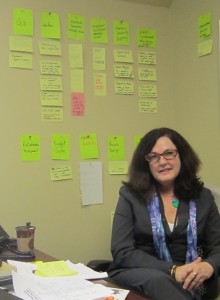
Burlington's Public Involvement Coordinator, Christine Iamonaco - if her public sessions are anywhere near as organized as those post it notes on the wall behind her desk the city will be well served.
Iamonaco got her first taste of what the good folks of Burlington are like, when she helped out with the Heritage Workshop that was held to calm the very troubled waters the good ship Registry sails on. There were well over 100 people at that event and it got noisy at times; but it was nothing like some of the garbage site selection meetings that Iamonaco handled in places like Chapleau and Kenora. “Those” Iamonaco will tell you “got really noisy.” When you try to tell people that there is going to be a garbage dump just down the road from where they live be ready for some reaction.”
A lot of her early work was done in the Waste Management field – where she developed plans for municipalities that had run out of space to put their garbage and needed to either open up new sites or expand existing locations.
A native of Ottawa, Iamonaco’s career started in retail where she found she liked talking to people. She saw a job that intrigued her and got into the waste management field, where she was a waste reduction facilitator in South Simcoe. That first brush with a larger public was the beginning of a career that brought her to Burlington with stops along the way in Kenora, and then ten years with the city of Toronto. A stint with BCHydro “before the department was gutted in 2007” and Iamonaco decided that it was time to get more formal education to compliment her experience in the field. She took a career curve and attended York University and left with a degree in Urban Studies.
What else does she bring with her? In her resume Iamonaco describes her skill set and experience this way:
I am a senior public involvement manager and coordinator, liaison, and facilitator with progressive planning experience. I have lead and prepared staff for specific roles in public involvement processes. I have created plans, strategies, and processes, in regulated and non-regulated environments. I am diplomatic and adept at contextualizing the issues and interests of multi-stakeholders. I am a strategic thinker who recognizes how company actions and messages will impact different stakeholder groups. I have clearly reported to government and stakeholders on issues, process progress, and emergent opportunities. I have established and managed a multitude of committees, advisory groups, peer review groups, and community liaison groups. Instrumental action in terms of managing conflicting community and corporate interests. Skilled group presenter, leader and trainer, adhering to IAP2 principles of inclusion and transparency.
IAP2 principles were used by Council and Staff when the Strategic Plan was created. Those same principles are going to be applied to the process of creating the Engagement Charter and are expected to be embedded within the Charter when it is finally ready for a trial run.
Iamonaco works out of a small office on the sixth floor and meets once a week with Kim Phillips to ensure that the time lines are being met and the objectives achieved.
After spending a couple of months getting the lay of the land, interviewing key people at the staff level and getting to know council members and meet with some of the stake holders, Iamonaco was ready to take her work plan into the field and work with the community to develop a Citizen’s engagement Charter – which is? And that’s where the job becomes one of educating first and then working with citizens as they fumble with their early understandings and over time get a deeper appreciation about just what it means to have an engagement Charter and then decide what to do with the thing once it has been put together. Iamonaco explains that an Engagement charter “improves the practice of information sharing.”
That assumes that the stakeholders actually want to share information. Does Council want to share and involve the citizens they represent, or do they see themselves as having been elected to run the city – and that they do – and come election time they get re-elected if they did a good job or shoved out if someone better comes along.
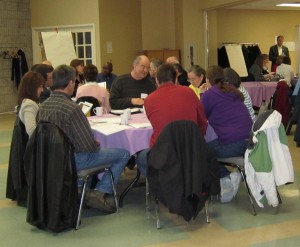
Participatory democracy - the public going over budget documents. Turnout was low - was the effort made worth the time - did it have any impact on the budget decisions?
Iamonaco explains that there are two types of democracy: representative democracies where you send someone to Ottawa or Queen’s Park and expect them to do the best they can for you or you have a participatory democracy where the citizens are involved right up to their ying yangs – if that’s what they want.
Council recently saw an example of participatory democracy, when people in the Orchard community flooded the Council Chamber saying what staff was recommending was totally unacceptable; then came in with ideas of their own that got right down into the nitty gritty of how much land they wanted dedicated to parks for their children. Based on how Council reacted a few weeks later on the Orchard issue, it would appear they are quite comfortable with having citizens at the table offering very detailed plans.
How far will Council – and staff for that matter – go with that approach? Staff will say – ‘hey we were hired to do this stuff’ and council may get to the point where they can only handle so much of a new approach. We are talking the protection of ‘turf’ here.
And that of course is what the Shape Burlington report was all about – they said the citizens wanted more say and they wanted to be consulted and be a real part of the decision making process.
Iamonaco found that the Shape Burlington report was the “push” that Burlington needed. “There were some very useful insights in the report; but real citizenship engagement comes when there is a willing council and the silos between the different parts of the civic administration are taken down.” Not always an easy task when their turfs are threatened.”
Iamonaco adds that “improving the practice of information sharing means building the capacity to participate – which is almost a straight line back to the information deficit the Shape Burlington Report highlighted. Burlingtonians have been so far removed from municipal participation, that they’ve forgotten they have a right to be at the table. Both Council and staff have been left to their own ways, which means that they are going to have to get used to citizens appearing and asking for more information and more participation.
What Burlington wanted to avoid was a situation similar to some of the early Strategic Plans – ‘oh we had one, but nobody did anything useful with what they had’. We now have a Strategic Plan that has become part of the process of getting things done. Any decision made is bounced off the Strategic Plan and the question: Does it fit with the Plan ? gets asked.
What approach will council take to the Engagement Charter? How will staff work with the thing? Well just what is the “thing”? It isn’t going to fall of the back of a truck and into our laps fully formed. The process will begin with a series of community information sessions. Five dates have been set with the locations set out below:
Community Engagement Information Sessions:
Monday, January 12, 7:30 to 8:30 p.m., Aldershot Arena, Community Room, 494 Townsend Avenue
Tuesday, January 17, 7 to 8 p.m., Mainway Recreation Centre, Auditorium, 4015 Mainway
Thursday, January 19, 7 – 8 p.m.; City Hall, 426 Brant Street Council Chambers (this session will be recorded for webcasting)
Thursday, January 19, 2 to 3 p.m.; City Hall, 426 Brant Street, Room 247
Thursday, January 26, 7 to 8 p.m.; Brant Hills Community Centre and Public Library, Nelson Room
These are “formation” meetings at which people will learn something about Engagement Charters. What are other cities doing? What are the upsides and the downsides of the different practices? Iamonaco is aiming for a “made in Burlington” Engagement Charter.
Iamonaco is looking at different levels of citizen participation. “Some people will choose to jump into this with both feet while others will want to just listen and monitor”, she points out.
Her objective is to pull together a group of people, who will work with her to determine what engagement model suits Burlington and then ideally produce something that is truly “Burlington” – made here to work here. We’ve not seen Iamonaco in action yet – she certainly speaks the language, but then so do most of the politicians we elect – it’s what happens to them when they get into office that’s the problem.
Iamonaco envisions a Charter Team – these are the people who will actually create the document. These people will meet often and Iamonaco hopes and expects there will be Council representation and senior staff representation involved in this as well as people from a good cross section of the community. She expects the group will number between 19 and 30 people.
She also wants to create a Virtual Team, that is people who are involved but not as directly. They get everything, they see everything and they can comment – but they may not be at the table doing the writing and the re-writing. Then there will be a Listen and Monitor Team – these are people who will be on a mailing list and just get material sent to them. Each of these groups will “self-organize”. Iamonaco’s role is to facilitate – not to create the document. She will be in place as probably the prime resource – but not the only resource. What she doesn’t know yet, is what kind of talent is out there and what kind of an appetite the community have for a charter?
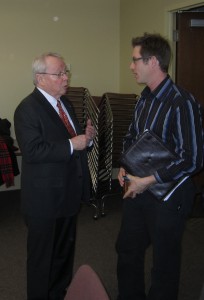
Burlington has had relatively large community protest groups in the past. The Save our Waterfront group had more than 1000 members - did it achieve anything other than getting its founder elected to city hall? Here, one of the masters of public involvement, former Toronto Mayor David Crombie talks with current SOW president.
This isn’t the sexist stuff to work through; but when completed it will result in an approach to citizen engagement that will move Burlington forward as a city whose citizens are aware, informed and active in the decision making process.
Iamonaco is going to have to work with both the people outside city hall and the people inside city hall. Far too many people have horror stories about how they were treated at one of the counters on Brant Street. We could tell you the story of a council member who was stunned with the treatment at the parking ticket counter. Pity that council member didn’t choose to go into the grubby little room, where you can plead your case at what is called the First Attendance office.
When we talk of getting things done in Burlington, mention is always made of the stakeholders” and of our desire to “partner” with others. Stake holders are often people, who feel they have a vested interest in something. They may not do very much of the heavy lifting, but they want and expect to be heard. What is really happening is that they are protecting a turf they have decided is theirs to protect.
Mayor Goldring moved through the “stakeholders” very early in the process of creating the Strategic Plan, where he was direct and not prepared to listen to much of the “same old, same old”. Some of those “stakeholders” were a little surprised, at the rate with which the Mayor went through their briefs. It was kind of healthy actually.
How radical a document is this Engagement Charter likely to be? Hey – this is Burlington – so let’s not let the word radical get put into use. It should be noted though, that there was a decent demonstration outside the Waterfront Hotel by the Stop Escarpment Highway Coalition. So – well we can dream, can we not?
When one listens to Christine Iamonaco, you will hear her talk about Burlington, that best kept secret, that hidden gem. Why change it, one might ask? Well John Boich did say that the relationship between the city and its citizens was toxic and when given an opportunity to take the words back and apologize for them – he didn’t.
Listen to the people who were really riled up over the way we handle, define and register buildings that are seen as “heritage” properties and you get a clearer understanding of where the problems exist. There were no deep dark secrets or an “agenda” within the Planning department. The problem was that citizens did not have clear information and that is more a community relations issue than a bureaucratic matter.
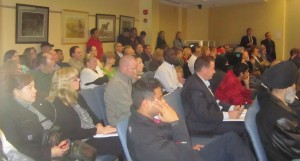
Orchard residents filled the Council chamber and gave council members a different pciture than staff had provided on creating park space in their community. We didn't have a Public Involvement Coordinator but the problem got resolved. Do we really need this position?
Had you had a chance to listen to the community delegation from the Orchard, when they were ticked with the way the city was handling the creation of some parkland for their children, and had you heard the rather weak excuse staff gave for putting forward the decision that was eventually turned down by council, you will get a sense as to why an Engagement Charter is needed. An interesting note: – the oversight for the Public Involvement Coordinator is being done by Kim Phillips. Can she bring city council around enough to have them go along with the process that Iamonaco is setting out to implement? And which council members are going to choose to be part of the process? And what impact will our new city manager have on all this?
Iamonaco brings an understanding of what people want when they talk of involvement. “The public” she will tell you “pushes when they want something. They usually want a say in the decisions being made on their behalf”. That she points out is what the Shape Burlington report did – “it was the push”. “There are some very good insights in that document and it is clear Iamonaco intends to use it as her starting point. And now that it is back up on the city’s web site – one would hope that everyone who is part of the Charter Team make a point of downloading the document and reading it from cover to cover.
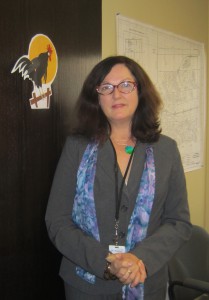
That rooster on the door of Christine Iamonao's office is her way of telling people "you have to start early" if you want to get the job done. As we get into January the city will see a blizzard of community meetings - five over a two week period, allowing all parts of the city to become informed and take part.
The start for Iamonaco is “improving the practice of information sharing”, which are words that will warm the cockles of Councillor Mead Ward’s heart. However, information on its own won’t make all that much of a difference. Iamonaco talks of “building capacity to participate” which means getting out into the community and explaining to people how they can take part. That kind of field work sticks in the craw of some of the council members, who feel that what happens in their ward is their concern and they don’t need some outsider who doesn’t have to manage the consequences, which they do come election day. As one council member put it at a meeting to think through what the job would mean – “will this person be taking the late evening calls at home, when something has gone wrong?”
Former prime minister John Turner recently said in a television interview that “democracy doesn’t just happen”. Iamonaco will tell you that this isn’t something she is going to do for the city of Burlington. Her job is to help the people in Burlington think through what they want and help them fashion the document they feel will give them what they want in terms of engagement charter. Her role is to listen to the participants and give them the guidance and direction to get to where they tell her they want to go.
Iamonaco says she would like to see a charter drafted and implemented by September of 2012 – and that is a bit of a stretch. However, what Iamonaco has going for her is the growing trend of taxpayers to be more involved. The internet has brought a lot more information to the public – they are now more informed and they don’t like some of what they see.

The Baby Boomers - they changed the way society worked every decade they went through - what will they do with Civic Engagement
Another factor that is in play is the appearance of the “baby boomers” as community activists. The “Boomers” have changed every level of society they were a part of. They changed our education system, they changed the way children were raised and they raised pure hell on university campuses around the world. They changed every level of entertainment. There is no reason to think that they won’t change what it is to be a senior. Gone will be the quiet, submissive senior who takes it on the chin.
Engagement Charters are an accepted part of municipal life in Australian and New Zealand. In Canada, Edmonton is the city with the most Engagement Charter experience where the initiative is a joint venture between the University of Alberta and the city.
For some communities the engagement charter is a policy, for others it is a collection of protocols and procedures; Burlington will have to decide, what it wants and then craft a document that sets out the rules of engagement – and then we can all have at it. This is a process that is just beginning.

















